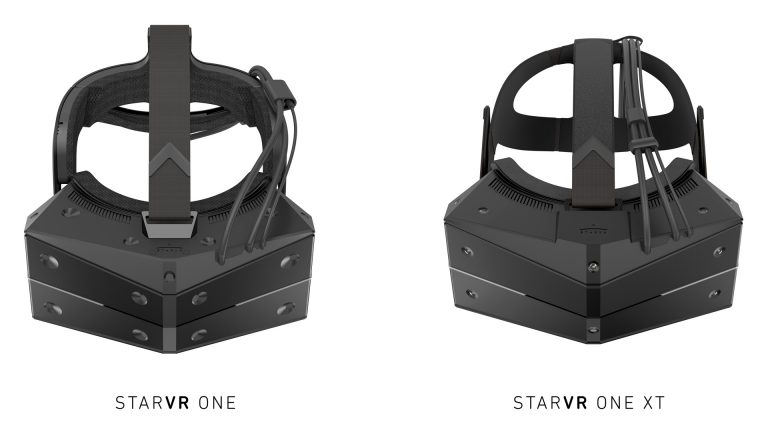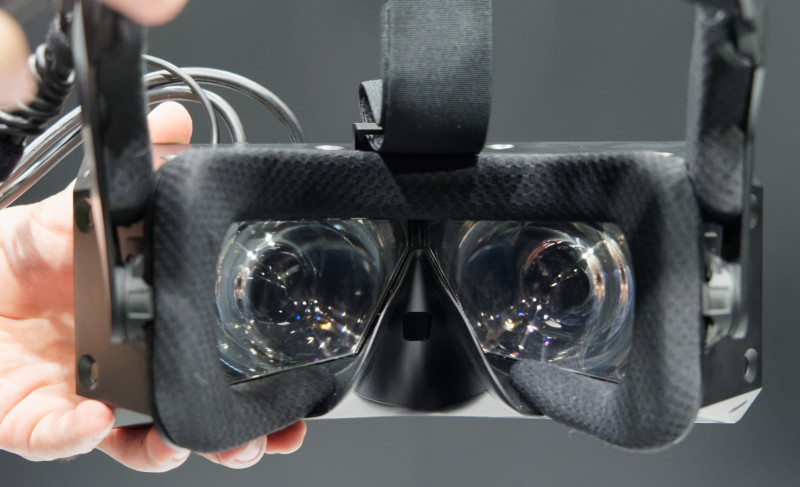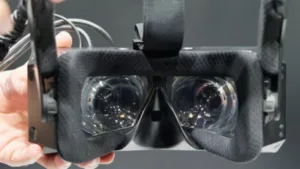StarVR is a company that we have been watching for a while, having first seen its VR headset at IFA in 2016. At the time, we weren’t over impressed with the quality. However, the firm (originally called Starbreeze) had convinced Acer to be a partner, and then a substantial investor, so it certainly had something. We heard that the company was developing the next generation of headset and at Laval Virtual a couple of months ago, the firm had its headset in a back area, and we nearly talked our way in, but someone spotted the Media badge and we wer prevented from seeing it!
However, the company launched the new headset at Siggraph with a well attended event on its booth and we also followed up with a meeting and demonstration. The StarVR One headset is unusual in having two full sized (4.77″) displays, each with resolution of 1830 x 1464 and is a rigid OLED that is custom made for StarVR that features RGB pixels, rather than a sub-pixel rendered system such as the one used by Samsung on its smartphones.
 The StarVR has Tobii gaze technology. Image:MekoStaff wouldn’t reveal who makes it, but they would confirm it was nobody in China, so our guess would be LG or Samsung. The optics of the headset have been designed to provide a 210 deg x 130 deg field of view, which makes the experience more immersive than other headsets. Refresh rate is 90Hz to avoid latency problems and to optimse the experience.
The StarVR has Tobii gaze technology. Image:MekoStaff wouldn’t reveal who makes it, but they would confirm it was nobody in China, so our guess would be LG or Samsung. The optics of the headset have been designed to provide a 210 deg x 130 deg field of view, which makes the experience more immersive than other headsets. Refresh rate is 90Hz to avoid latency problems and to optimse the experience.
The headset is fitted with gaze tracking which can be used for foveated rendering and analytics, but is also used to measure the interpupillary distance (IPD) for the user which helps to make the optics more comfortable – an important feature as the headsets are aimed at professional applications, where users may be wearing the headsets for extended periods of time. The analytics can be useful for developers to help them understand how users are reacting to the content. The gaze software comes from Tobii.
The tracking system is different for the two variations of the headset. The One is the ‘basic’ unit, which comes with a SteamVR tracking system for tracking volumes up to 10m x 10m, while the XT, which is aimed at enterprises, has integrated active optical markers that can be used with a number of different tracking systems, and a range of plug-ins to support different trackers is available.
 The two headsets have different tracking
The two headsets have different tracking
A surprising feature is that the colour is very carefully processed and the company told us in our interview that the displays can be calibrated both to ensure good matching and to simply ensure as much accuracy as possible for design applications.
The weight of the One is 450g and the XT is 430g (plus the headstrap/headband and cables). The system uses dual cables, with Type C and supporting DisplayPort Alt mode. One cable is used for each display and the company is confident that the dual USB 2.0 systems are able to support the data coming back from the headset.
The headset needs at least an Intel i7-7700 or AMD Ryzen 7 2700X with an Nvidia GeForce GTX1080 (although in the demos, the company had one of the new Nvidia boards). Detailed pricing is not yet available, but these headset will not be cheap.
Analyst Comment
I was impressed with the demonstration and that is in strong contrast to the demoes at IFA. The quick alignment and IPD measurement probably help but the industrial design is also better. The screen door effect is barely detectable (I could see it, but others say there is no effect, so it is clearly close to gone for everybody). I could see a very subtle pattern that looked almost like scratches on the display and Marquez told me that it was ‘mura’ and the company is continuing to improve the issues.
The wide field of view means a big fresnel lens is being used and I had heard from Jon Peddie that he thought that he could see some significant fringing from the lens, but I can’t say that I saw much of it. There was some fringing, but more like a not very good camera rather than the typical level of VR headsets – and that’s impressive in such a big lens. Of course, the content in the demos was probably optimised to limit the effect, but Emmanuel Marquez, the company’s CTO and who is based in Barcelona, told me that five years work had gone into the design and even though the firm has a sophisticated optical bench, defects still appeared to the eye.
 The StarVR One has big lenses for the wide FOV. Image:Meko
The StarVR One has big lenses for the wide FOV. Image:Meko
Having a completely customised display really helped to get optimisation between the OLEDs and the lenses, Marquez told me. I asked if a flexible display that could be shaped would be helpful, but Marquez didn’t think it would be a big advantage, but he hadn’t checked as his volume is low compared to typical smartphones, so supply would probably be a challenge. Contrast was good, as you would expect – but we didn’t get any sense of the colour accuracy.
The demonstration was designed to run initially with the kind of FOV of an HTC or other current goggles and then switched to the wide view of the One. It was impressive.
In his presentation and also in the interview, Marquez kept highlighting the ‘low weight’ of the headset, but I can’t say that I found it light. 450gms is a lot (with straps, cables and headphones as well) although the design was probably as good as it could be in comfort terms. Cyclists always complain about the weight of their helmets, but the One weighs around double a typical good quality unit. (BR)

